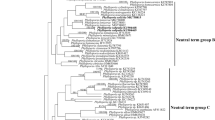Abstract
Based on 28 taxa, including six species of Phylloporia, and respectively one representative of 17 genera of the Hymenochaetales, a phylogenetic analysis of a region of the large subunit of the nuclear encoded ribosomal DNA was performed. Molecular sequence data as well as morphological and anatomical features show the genus to be monophyletic. Next related to Phylloporia is Fulvifomes. The phylogenetic relationships of Phylloporia are discussed. In addition the genus Phylloporia is monographed; 12 species are accepted and described with a key.
Similar content being viewed by others
References
Dai Y-C (1995) Changbai wood-rotting fungi 3. The genus Phellinidium (Basidiomycetes) and a new species, P. aciferum. — Annales Botanici Fennici 32: 63–73.
Dai Y-C (1999) Phellinus sensu lato (Aphyllophorales, Hymenochaetaceae) in East Asia. — Acta Botanica Fennica 166: 1–115.
Danielson RM (1984) Ectomycorrhizal associations in jack pine stands in northeastern Alberta. — Canadian Journal of Botany 62: 932–939.
Domanski S, Orlos H, Skirgiello A (1967) Gryzby, vol 3. Warsaw.
Donk MA (1969) Revision der Niederländischen Heterobasidiomycetidae und Homobasidiomycetidae-Aphyllophoraceae. Bibliotheca Mycologica 21. J. Cramer: Berlin, Stuttgart.
Donk MA (1974) Checklist of European polypores. Verhandelingen der Koninklijke Nederlandse Akademie van Wettenschappen. Afdeling Natuurkunde. Tweede Reeks 62. North Holland Publishing Company: Amsterdam, London.
Felsenstein J (1985) Confidence limits on phylogenies: an approach using the bootstrap. — Evolution 39: 783–791.
Felsenstein J (1995) PHYLIP (Phylogeny Inference Package). Version 3.5c. Department of Genetics, University of Washington: Seattle.
Fiasson JL, Niemelä T (1984) The Hymenochaetales: a revision of the European poroid taxa. — Karstenia 24: 14–28.
Fischer M (1996) On the species complexes within Phellinus: Fomitiporia revisited. — Mycological Research 100: 1459–1467.
Hibbett DS, Donoghue MJ (1995) Progress toward a phylogenetic classification of the Polyporaceae through parsimony analysis of mitochondrial DNA sequences. — Canadian Journal of Botany 73(Suppl. 1): S583–S861.
Hibbett DS, Thorn RG (2001) 5 Basidiomycota: Homobasidiomycetes. In McLaughlin, McLaughlin, Lemke (eds) The Mycota VII Part B Systematics and Evolution, pp. 121–168. Springer Verlag: Berlin, Heidelberg.
Holmgren PK, Keuken W, Schoefield EK (1981) Index herbariorum, part I. The herbarias of the world. — Regnum Vegetabile 106: 1–452.
Kirk PM, Ansell AE (1992) Authors of fungal names. A list of authors of scientific names of fungi, with recommended standard forms of their names, including abbreviations. Index of Fungi Supplement. CABInternational: Wallingford.
Kotlaba F & Pouzar Z (1978) Notes on on the Phellinus rimosus complex (Hymenochaetaceae). — Acta Botanica Croatica 37: 171–182.
Lee SB, Taylor JW (1990) Isolation of DNA from fungal mycelia and single cells. In Innis MA, Gelfand DH, Sninsky JJ, White TJ (eds) PCR protocols pp. 282–287. Academic Press: San Diego.
Murrill WA (1904) The Polyporaceae of North America-IX. — Bulletin of the Torrey Botanical Club 31: 593–610.
Murrill WA (1905) The Polyporaceae of North America-XI. — Bulletin of the Torrey Botanical Club 32: 353–371.
Murrill WA (1907) (Agaricales) Polyporaceae. — North American Flora 9: 1–131.
Niemelä T, Wagner T, Fischer M, Dai Y-C (2001) Phellopilus gen. nov. and its affinities within Phellinus s. lato and Inonotus s. lato (Basidiomycetes). — Annales Botanici Fennici 38: 51–62.
Ryvarden L (1972) A critical checklist of the Polyporaceae in tropical East Africa. — Norwegian Journal of Botany 19: 229–238.
Swofford DL (1999) PAUP: phylogenetic analysis using parsimony. Version 4.0b2. Smithsonian Institution, Washington: DC.
Thompson JD, Gibson TJ, Plewniak F, Jeanmougin F, Higgins DG (1997) The ClustalX windows interface: flexible strategies for multiple sequence alignment aided by quality analysis tools. — Nucleic Acids Research 24: 4876–4882.
Wagner T (2001) Phylogenetic relationships of Asterodon and Asterostroma (Basidiomycetes), two genera with asterosetae. — Mycotaxon 79: 235–246.
Wagner T, Fischer M (2001) Natural groups and a revised system for the European poroid Hymenochaetales (Basidiomycota) supported by nLSU rDNA sequence data. — Mycological Research 105: 773–782.
Author information
Authors and Affiliations
Corresponding author
Rights and permissions
About this article
Cite this article
Wagner, T., Ryvarden, L. Phylogeny and taxonomy of the genus Phylloporia (Hymenochaetales). Mycol Progress 1, 105–116 (2002). https://doi.org/10.1007/s11557-006-0009-8
Accepted:
Published:
Issue Date:
DOI: https://doi.org/10.1007/s11557-006-0009-8




